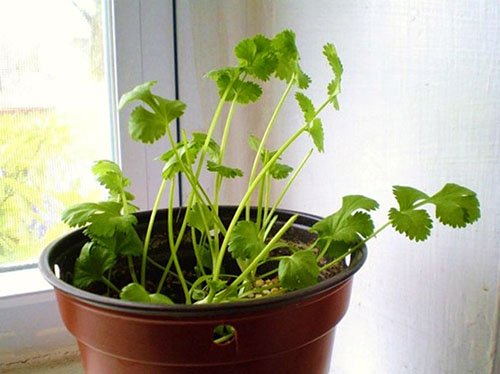Growing and caring for cilantro at home
Content
Growing conditions
Cilantro loves fertile soil, abundant watering and good lighting. These greens can also be grown in shaded areas, on sparse soil, the plants will be pale and stunted, and the reserves of essential oil, for which cilantro is so prized, will tend to a minimum, no matter how hard you put in. The soil for growing cilantro should be slightly alkaline or neutral, well fertilized, ideally, the beds are dug up in the fall, with the introduction of superphosphate. To grow greens in a greenhouse or in pots on a windowsill, you can take a mixture of garden soil, sand, humus and wood ash.
Regardless of whether it is growing in beds or in closed ground, regular watering is necessary, at least twice a week - this contributes to good growth of green mass. If you plan on growing greenery in a greenhouse or on a windowsill, choose the southern side so that the plants get enough light. Or consider additional lighting to make it easier to grow and care for and get the highest quality greens possible.
Video "Detailed instructions"
We bring to your attention detailed instructions for growing cilantro all year round.
How to sow cilantro
At home and in a greenhouse, cilantro can be sown from the beginning of March, and in open ground in the country - when the soil warms up to at least five degrees. Cilantro is sown with seeds. The seeds must be no more than two years old, otherwise they will lose their germination. If you soak the seeds a day before sowing, then cilantro rises better. When growing cilantro in pots, three to ten seeds can be laid in one pot (they are quite large in cilantro). Cilantro is sown in boxes in rows, with a distance of five to ten centimeters between them.
In the greenhouse, to facilitate the work, you can use a different scheme - about 10 centimeters between the bushes, twenty to thirty centimeters between the rows. The seeds are buried in the soil one and a half to two centimeters deep, sprinkled with earth, watered. The pots and boxes on the windowsill must be covered with a film that remains until the first leaves appear at the seedlings. From this moment, active plant care begins.
The greens sown in the greenhouse will be usable two to three weeks after planting, the greens on the windowsill will germinate a little longer, but after two and a half weeks it will also please. To constantly get fresh cilantro greens, it is recommended to plant it in a small area, but renew the planting every two weeks.
Care after landing
Care consists of removing excess plants and weeds, watering carefully, and providing additional lighting (if cilantro is grown at home). The main thing in caring for cilantro on the windowsill is timely thinning. If the plants grow too densely, then they will not gain green mass, but will drive out the peduncles. Thus, one, the strongest, should be left from several plants. The optimal area for feeding one plant is thirty-five square centimeters, whether in the country, in a greenhouse or in a box.
The situation with weeding is similar to thinning - if there is too much growing around the cilantro, it will drive out the peduncle, and the greens will be small and inconspicuous.Although, naturally, the need to weed arises more often in the garden than in the greenhouse or in the boxes on the windowsill. There is an algorithm for watering cilantro. From the moment of sowing to the appearance of the first leaves, watering should be abundant. Further, watering is reduced, and within a week and a half, the soil should be just moderately moist. With the transition to active vegetation of greens, cilantro is watered again abundantly. In addition to the plants from which you need to get seeds - when the seeds ripen, watering should again be moderate.
In this case, excess water is drained from the pallets (if you grow greens on the windowsill). Abundant watering in the greenhouse should also not be excessive, since excess moisture can provoke powdery mildew disease. Caring for cilantro in a greenhouse or vegetable garden involves loosening row spacings and mulching to better retain moisture. When growing cilantro at home on a windowsill, it is important to remember about additional lighting. In order to extend the period of growing green mass, the cilantro is pinched on the peduncles, this is especially important for growing at home or in pots in the country.
Harvesting
Cilantro greens are harvested after the appearance of five to six true leaves and before forcing the peduncles. After the appearance of peduncles, the greens coarse and lose their taste. In the greenhouse, it is customary to cut the greens; on the windowsill it is better to pinch off the leaves themselves in different pots. It is also recommended to pinch off the upper ovaries. Thus, you will always have fresh cilantro for meat dishes, salads, soups, marinades or for barbecue in the country. Greens can also be dried.
To begin with, the cut stems are washed well, then laid out to dry under a canopy or at home not far from the window. The basic rule for drying cilantro is in the shade, but with access to fresh air. Grind the greens after drying. If desired, you can leave the flower stalks until ripening, although this is easier to do in the garden, and not at home. Ripe cilantro seeds can be used for planting next year or in cooking - this is the well-known coriander seasoning. As you can see, growing and caring for cilantro at home is not a big deal. With just a little work, you can collect as many greens as you like on the windowsill all year round.
Video "How to plant greenery at home"
An illustrative video that will answer many questions.




